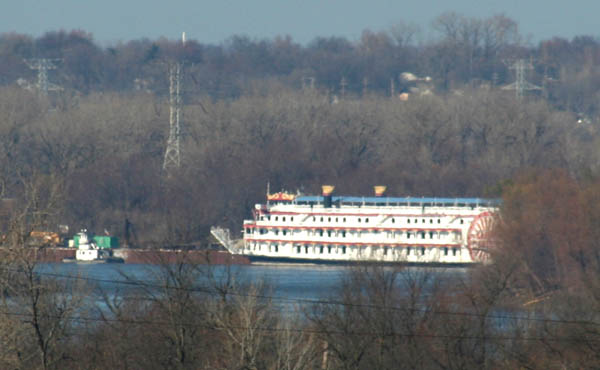Built St. Louis > >St. Louis Riverfront
|
|
With the "long-term and enduring" part out of the way, we turn our attention to the flimsy, short-term and transient. St. Louis has never figured out how to properly capitalize on the crowds that flock to the riverfront to visit the Gateway Arch. An ever-shifting array of tourist concerns has occupied small moored barges and docks at the river's edge as long as I have known St. Louis. Among them have been a floating McDonald's (lost in the 1993 flood), a World War 2 minesweeper ship (also lost in the Great Flood), and various touring boats (diesel barges gussied up as "steamboats"). The closest thing to successful commercialization of the river has been the rise of riverboat casinos in the 1990s. Even this is debateable - while several casinos have clustered at the river, these venues by their nature do not actually participate in the life of the river. The garishly-advertised Casino Queen was originally required to make regular cruises (one of the biggest shocks of my life came when I was visiting the Arch in 1993, and looked up to see the Queen awkwardly turning around in the middle of the river. That awkward barge could actually move under its own power!) The State of Illinois legalized gambling on permanently docked vessels in 1999, however, and the Queen became stationary immediately afterwards. When the casino gained a land-based license in 2009, the ship was removed entirely. |
|
|
"Steamboats" - actually diesel-powered barges with passenger decks on top, garnished with cheap ornament and fragile-looking paddle wheels and smokestacks (both non-functional) - wait to take passengers on cruises up and down the river. The flagrant stab at nostalgia is reinforced by jazz music blaring from lo-fidelity megaphones, an aural assault that can be heard all the way up to the top of the Arch steps. (Like most commecialized nostalgia, the exact time period they're shooting for is a little fuzzy - the steamboat trade diminished after the Civil War, while New Orleans-style jazz did not rise to prominence until the 1920s.) Tourists indulging in this obvious invitation to yesteryear must be rather shocked to discover the true nature of the Mississippi River. Apart from the downtown skyline, the city of St. Louis is hardly visible from the river at all. Banners and slogans may tell you that this is "the best way to see St. Lous", but unless one is an affictionado of industry, it truly is not. |





